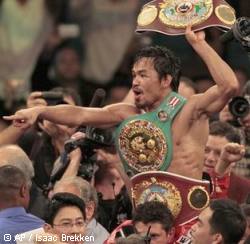
|
Philippines, 03 Aug 2025 |
Home >> News |
 |
||||
|
|
|
|
HAS PACQUIAO MADE BOXING RELEVANT AGAIN? By Rene Bonsubre, Jr. PhilBoxing.com Wed, 18 Nov 2009  Esteemed American journalist Heywood Broun wrote in a 1937 article: “It seems to me that the newspapermen assigned to cover the sport are among the most talented of reporters. The average managing editor in handling his forces uses his brightest workers for baseball and for boxing. Floods and strikes are covered by the second stringers.” Hard to believe that boxing reached such heights in terms of significance; that American newspapers would assign their best writers to cover the sport. This was boxing prior to World War II; when New York’s Madison Square Garden was the boxing capital of the world and epic fights drew audiences of tens of thousands packing baseball stadiums. Boxing always had a loyal following in the Philippines. It’s one of the few things where we can actually compete on even terms with the rest of the world. From the three greatest Filipino pugilists - Pancho Villa to Flash Elorde to Manny Pacquiao – there were others in between who held our interest. There is a 21 year gap between Mike Tyson and Pacquiao appearing on the cover of TIME magazine. This mirrors the decline of boxing’s popularity through the decades, as far as developed countries were concerned. Boxing was no longer available on U.S. public television and big fights were only seen on pay-per-view. Former two division world champ Joe Calzaghe was quoted as saying that boxing is a dying sport. Boxing now has to compete with the Mixed Martial Arts and the UFC for pay-per-view buys. Boxing’s critics have said time and time again that it is boxing that is destroying itself with its politics and diluted titles. Pacquiao is in a way fortunate that interest in the heavyweight division has declined. There was a time when the heavyweight champion of the world was larger than life. World title fights in boxing’s glamour division made the entire planet stop and watch. Title fights also used to reflect the social and political climate of their times. Jack Johnson’s 14th round KO win over Tommy Burns in 1908 not only gave the world its first black heavyweight champion, it became a rallying cry for white racists who wanted to set things right again by having a white boxer as the sport’s most powerful. Joe Louis’ one round demolition of Max Schmeling in 1938 was a blow against Aryan supremacy and watched by a world on the brink of a second world war. One of the journalists who covered the fights of Louis was Ernest Hemingway, who would later win a Nobel Prize in Literature. Muhammad Ali was stripped of his license for refusing the Vietnam War draft. His battle outside the ring became a significant part of the U.S. Civil Rights movement during the tumultuous 1960’s. When he was allowed to fight again, he became the most famous man on earth. Pacquiao and Sugar Ray Robinson are the only two non-heavyweights to grace the cover of TIME. In 1951 Robinson inspired the term ““the greatest all-around fighter pound-for-pound in any division.” His reluctant heir, Manny Pacquiao, calls himself an ordinary fighter. But Pacquiao is also a failed political candidate despite his intentions to change things and help people. He is not the same firebrand as Ali. Pacquiao has remained friendly with the widely unpopular Arroyo administration. The influential opinion makers in the media and the majority of Filipinos would rather have Pacquiao become a force for good outside of politics. One day before Pacquiao beat Miguel Cotto of Puerto Rico for his seventh world title, another Filipino boxer Z “The Dream” Gorres had to undergo emergency neurosurgery after winning his fight against Luis Melendez of Colombia. It is a grim reminder of the inherent risks of the sport and one of the main reasons why boxing lost its popularity among the rich nations. Boxing remains popular in the developing countries. Its hook remains in its being an avenue to escape poverty. But not all poor kids become boxers. There is something inside those who are brave enough to risk everything inside the ring. Therein lies the sport’s continuing mystique. Pacquiao’s popularity has also been boosted by the world wide web. For the past six years Filipinos from all over the globe have rallied around him in internet forums and chat rooms. But Pacquiao’s recent string of one-sided victories has surprised even his most rabid supporters. Pacquiao’s fights are now being covered by CNN, BBC and major journalistic institutions like the New York Times, Washington Post and the Wall Street Journal. But can he bring boxing back to the same level of esteem and recognition reached during the Ali era? Pacquiao made his countrymen hope and dream again. The rest of world is still trying to catch up. Click here to view a list of other articles written by Rene Bonsubre, Jr.. |
|
|
PhilBoxing.com has been created to support every aspiring Filipino boxer and the Philippine boxing scene in general. Please send comments to feedback@philboxing.com |
PRIVATE POLICY | LEGAL DISCLAIMER
developed and maintained by dong secuya © 2025 philboxing.com. |